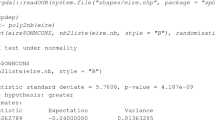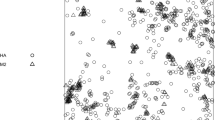Abstract
In some spatial applications the objects of interest are fields, caused by spatially distributed sources, and one of the central questions is to find neighborhood relations between these fields. The motivating example for this paper is a cellular network: base transceiver stations transmit signals with continuous distribution, the signal strength, in an urban environment. In order to avoid interference, neighbored transceivers must not use the same frequency, so that neighborhood knowledge is one key to frequency planning. In this paper we define a concept of neighborhood for fields, and we propose a vector-based model to determine neighborhoods between given fields. In contrast to this vector-based model, the commonly used raster-based models suffer in urban areas from their resolution as well as from the prediction of signal propagation.
Similar content being viewed by others
References
T. Bittner, “Rough location,” Ph.D. thesis, Department of Geoinformation, Technical University of Vienna, Vienna, 1999.
A.G. Cohn, B. Bennett, J. Goodday, and N. Gotts. “Qualitative spatial representation and reasoning with the region connection calculus,” Geoinformatica, Vol. 1(3):1-44, 1997.
A.G. Cohn and N.M. Gotts. “The ‘Egg-Yolk’ representation of regions with indeterminate boundaries,” in P.A. Burrough, A.U. Frank, (Eds.), Geographic Objects with Indeterminate Boundaries. GISDATA. Vol. 2. Taylor & Francis: London, 1996.
B.D. Dent. Principles of Thematic Map Design. Addison-Wesley Publishing Company: Reading, Mass, 1965.
M.J. Egenhofer. “Spatial query languages,” Ph.D. thesis, University of Maine, Orono, Maine, 210, 1989.
M.J. Egenhofer. “Reasoning about binary topological relations,” in O. Günther and H.-J. Schek, (Eds.), Advances in Spatial Databases (SSD `91). Lecture Notes in Computer Science, Vol. 525, 143-160, Springer: Berlin, 1991.
M.J. Egenhofer and R.D. Franzosa. “Point-set topological spatial relations,” International Journal of Geographical Information Systems, Vol. 5(2):161-174, 1991.
A.U. Frank. “Qualitative spatial reasoning: Cardinal directions as an example,” International Journal of Geographical Information Systems, Vol. 10(3):269-290, 1996.
A. Kak. “Spatial reasoning,” AI Magazine, 9:23, 1988.
D. Lang. “Vector-based GIS-algorithm for planning and optimizing cellular telecommunication networks,” Diploma thesis, Department of Geoinformation, Technical University of Vienna, and Department of Geography, University of Vienna, Vienna, 1999.
M. Molenaar. “Spatial objects without boundaries,” in W. Shi, M. Goodchild, P.F. Fisher, (Eds.), Proceedings of the International Symposium on Spatial Data Quality. Department of Land Surveying and Geo-Informatics. The Hong Kong Polytechnic University: Hong Kong, 479-486, 1999.
M. Mouly, M.-B. Pautet. The GSM System for Mobile Communication. Cell & Sys, Palaiseau, 1992.
G. Nowok. Zellen. Course Material, DeTeMobil Training Center, Nürnberg, 1995.
D. Papadias, N. Karacapilidis, D. Arkoumanis. “Processing fuzzy spatial queries: A configuration similarity approach,” International Journal of Geographical Information Science, Vol. 13(2):93-118, 1999.
D.A. Randell, Z. Cui, A.G. Cohn. “A spatial logic based on regions and connection,” in B. Nebel, W. Swarthout, C. Rich, (Eds.), Third Conference on Principles of Knowledge Representation and Reasoning. Morgan Kaufmann: Cambridge, 165-176, 1992.
T.S. Rappaport. Wireless Communications. Principles & Practice. Prentice-Hall Company: New Jersey, 1996.
S. Scheinert. Begriffsdefinitionen für die Funknetzplanung. Handbuch Planung and Aufbau, 7. DeTeMobil, 1995.
E. Siebe, U. Büning. “3-D-Stadtmodelle für Funknetzplanungen im Mobilfunkbereich,” Geo-Informations-Systeme, Vol. 9(4):21-29, 1996.
V. Turau. Algorithmische Graphentheorie. Addison-Wesley: Bonn, 1996.
R.J. Wilson, L.W. Beineke, (Eds.), Applications of Graph Theory. Academic Press: London, 1979.
S. Winter. “Location similarity of regions,” ISPRS Journal of Photogrammetry and Remote Sensing, Vol. 55:189-200, 2000.
M. Worboys. “Imprecision in finite resolution spatial data,” GeoInformatica, Vol. 2(3):257-279, 1998.
Author information
Authors and Affiliations
Rights and permissions
About this article
Cite this article
Lang, D., Winter, S. & Frank, A.U. Neighborhood Relations between Fields with Applications to Cellular Networks. GeoInformatica 5, 127–144 (2001). https://doi.org/10.1023/A:1011434114316
Issue Date:
DOI: https://doi.org/10.1023/A:1011434114316




